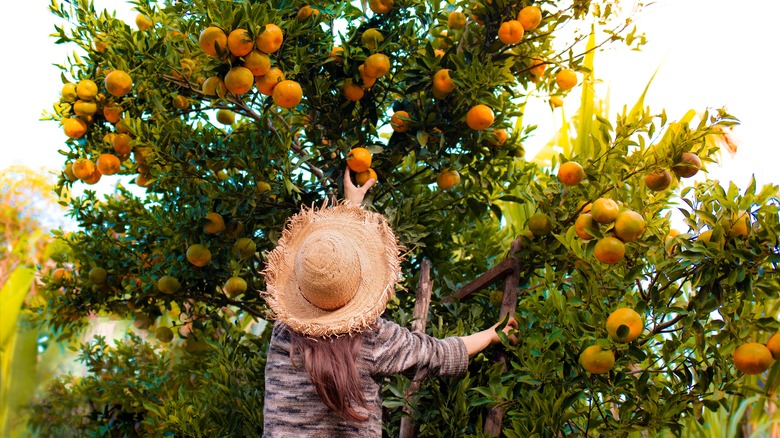Citrusy Fruits Are The Key To Attracting Butterflies To Your Garden
Nothing gives a gardener more pleasure than seeing their garden thriving and being in harmony with insects and birds alike. Looking out into your garden and seeing hummingbirds fluttering near your flowers, hearing bees buzzing, and watching butterflies float from fruit to flowers is a wonderful sight every gardener should have the opportunity to enjoy. If you want to turn your garden into a haven for birds and insects, you need to plant the right flowers and trees to attract them. Planting citrus trees in your yard is a great way to attract beautiful butterflies to your garden.
Depending on what you plant, you can transform your yard into a haven for butterflies right throughout their lives. From good foliage that provides safe nesting to lay their eggs and feed the larvae (caterpillars). The branches of citrus trees are great for camouflage and safely hosting the chrysalides of certain butterfly species, where the fully grown caterpillars will cocoon themselves as they transform. While other butterfly species prefer flowers and plants for their sap, the Great Swallowtail butterfly is known to favor citrus trees that provide them with everything they need to survive beyond just food.
How to plant a garden for butterflies
When planting a garden for butterflies, you want to think beyond food. Butterflies have various needs, and they also happen to be picky. You can plant lemon trees from seed, but if you're keen to bear the fruits of your labor a little sooner, you can opt for lemon trees and other dwarf varieties of orange, mandarin, or grapefruit trees from nurseries instead. If you have the space, planting a variety of citrus will be more beneficial in your mission to attract butterflies to your garden. Different tastes and colors are better at attracting butterflies than one type of fruit or color.
If their wings weren't an obvious enough hint, butterflies love color and texture so pairing your citrus fruits with other plants and flowers will have your butterflies spoilt for choice. For younger larvae, you could plant milkweed, dill, and aster. Even though some butterflies prefer citrus foliage to lay their eggs, some butterfly species like Monarch caterpillars only eat milkweed, so it can be beneficial either way. For fully matured butterflies, ironweed, goldenrods and coneflowers planted in-between marigolds, lavender, snapdragon, and nettle make for a great balance of great color and different taste. Citrus trees will provide food and safe nesting, but planting shrubs along the perimeter of your garden will provide adequate shelter for your butterflies during windier and rainy days.
Tips to make your butterflies feel at home in your citrus garden
It would be nice to provide spaces that give your butterflies something to do when they're not eating or laying eggs. Butterflies love to gather around puddles after the rain where they can soak up those minerals as the water evaporates. You can create puddles for them by placing shallow container like wide lids in a few spots in your yard. Pour water or other sweet drinks the butterflies will enjoy along with overripe fruit. Change the liquids and the fruit out regularly to avoid attracting pests. Butterflies also appreciate lawn just as much as the next insect and it will give them an open space to enjoy the sun as they like to sun bathe on warmer days.
Citrus can also be incorporated into other parts of your garden where they can serve various purposes. Place citrus rinds in-between your crops to repel pesky pests from your garden while also attracting pollinators and good predators to your plants. Avoid using pesticides and herbicides in your yard because they are known to be harmful to pollinators like bees and butterflies and other good predators like ladybugs, ground beetles and spiders. If you feel like you've been left with no choice, consider placing other attractive plants in containers a little distance away from where you'd be spraying the chemicals.


